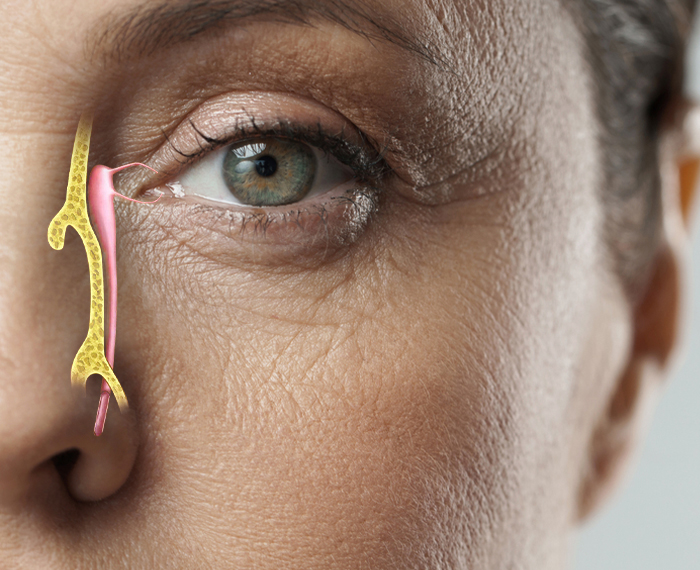
Disorders Of Lacrimal System
The tear is secreted from the main gland in the upper outer part of the eye and the auxiliary glands in the conjunctiva and lids. Provides gliding, protection and clarity by dispersing on eye surface. Then the eyelids close to the nose in the lower and upper holes entering through the small channels are poured into the tear sac. From here it is transmitted to the nose by another channel.
Dry eye syndrome
Tears are produced in two ways. One of these is the slow and constant production of tears and provides normal eye slippery. The other is the release of large amounts of tears in response to eye stimulation or emotional state. Some people may not have enough tear secretion to make the eye comfortable. This condition is called dry eye.
Symptoms of Dry Eye
- Stinging and burning in the eyes,
- Itching,
- Adhesive secretion in eyes,
- Cigarette smoke or wind discomfort in the eyes,
- Excessive watering,
- Difficulty wearing contact lenses.
Excessive watering from a dry eye appears to be abnormal, but if the eye does not have tears to provide lubrication, the eye becomes uncomfortable and stimulated. Excessive tear secretion occurs, which flows out of the eye because the drainage system of the eye cannot handle it.
Causes of Dry Eye
As you age, tear production is normally reduced. Although dry eye can occur in any person at any age, it is more common in women. This is especially true after menopause. In arthritis, dry eye, as well as dry mouth may be. Dry eye, dry mouth and arthritis together form Sjogren’s syndrome. Many medications can also cause dry eyes. Some of them are urine-enhancing drugs, heart medications, blood pressure medications, glaucoma medications, allergy medications, sleeping pills, nerve medications and painkillers. As these drugs are frequently used, the dry eye condition is either tolerated or treated with “artificial tears.. Therefore, you should tell your doctor about all the medications you are taking.
People with dry eyes are more sensitive to the side effects of all eye medications. For example, some eye drops and preservatives in artificial tear preparations may disturb the eye. Special, non-protective artificial tears may be required.
People with dry eyes are more sensitive to the side effects of all eye medications. For example, some eye drops and preservatives in artificial tear preparations may disturb the eye. Special, non-protective artificial tears may be required.
How is Dry Eye Diagnosed?
Dry eye can be diagnosed with a simple eye examination. Sometimes tests that measure tears may be necessary. In the Schirmer tear test, filter paper pieces are placed on the inside of the lower lid and tear production is measured under different conditions. In another test, fluorescein or Rose Bengal dyes are added to the eye to investigate specific staining patterns.
How is Dry Eye Treated?
Adding tears
Artificial tears are similar to normal tears. They lubricate and moisturize the eye. If there is sensitivity to preservatives in artificial tears, artificial tears without preservatives can be used. Use of tear-free tears may give better results if frequent drops are needed. There are also solid tear preparations which are placed daily into the lower lid and exhibit slow release.
Bandage contact lens
It is preferred when severe disturbances occur on the surface of the eye, but in this case the use of tear drops is continued.
Tear protection
Protecting the eye’s own secretion is another way of keeping the eyes moist. The tear passes from the eye to the nose through a small canal. The mouth of these channels may be temporarily or permanently obstructed. Thus, the tear is protected, as well as prolonged the effect of artificial tears.
Clogging of the tear ducts is done with some plugs, adhesives or electrocautery. Some of these may have temporary and some may have permanent effect. Depending on the situation, one of these may be selected, or, after applying one of the temporary methods, a permanent attempt may be made if excess watering does not occur.
Clogging of the tear ducts is done with some plugs, adhesives or electrocautery. Some of these may have temporary and some may have permanent effect. Depending on the situation, one of these may be selected, or, after applying one of the temporary methods, a permanent attempt may be made if excess watering does not occur.
Other methods
Tears evaporate like other liquids. This can be done to prevent evaporation. When the temperature inside the house increases in winter, water can be humidified by putting water into the radiator. Goggles with environmental protection in dry weather reduce drying.
Dry eye patients should avoid all factors such as excessive hot room, hair dryers or wind which cause dryness. Smoking is also harmful. Some patients with dry eyes complain of not being able to open their eyes in the morning. This complaint can be remedied by using an artificial tear ointment at night.
Dry eye due to vitamin A deficiency is common in poor countries and especially among children. Vitamin A supplementation is of little benefit to dry eye patients caused by abnormal conditions such as Stevens-Johnson syndrome or pemphigoid.
Dry eye patients should avoid all factors such as excessive hot room, hair dryers or wind which cause dryness. Smoking is also harmful. Some patients with dry eyes complain of not being able to open their eyes in the morning. This complaint can be remedied by using an artificial tear ointment at night.
Dry eye due to vitamin A deficiency is common in poor countries and especially among children. Vitamin A supplementation is of little benefit to dry eye patients caused by abnormal conditions such as Stevens-Johnson syndrome or pemphigoid.
Eye Irrigation
If the tears produced by the tear glands are more than the tears sent to the nose, watering in the eye or even overflowing out of the lids will occur. Cold, hot, light, crying, excitement, fatigue can occur in situations such as tears, as well as this may be a symptom of some disorders.
Causes of Eye Irrigation
Eye watering may occur for the following reasons:
- Disorders of the conjunctiva or cornea,
- Eyelid disorders,
- Intraocular inflammation,
- Foreign body leakage into the eye,
- Glaucoma in children (high intraocular pressure),
- Obstruction or stenosis in tear ducts
How to Identify Congestion in Tear Channels?
After the other reasons of eye watering are excluded by a detailed examination, a non-pointed needle is inserted through the tear holes and the fluid is given. Medicated films may be required to ensure that the duct is closed or to locate the obstruction.
How to Open Congestion in Tear Channels?
Obstruction or stenosis of these ducts is common in infants and usually opens up to one year of age. If it is not opened until this time, catheter is applied under general anesthesia. If this cannot be achieved, surgery is performed at an advanced age (from 4 years of age).
Surgery is generally preferred in adults and it is beneficial not to leave it to the elderly. The technique varies depending on the level of obstruction and sometimes tube application may be required. In this case, the tube is left in the tear duct for a long time.
Surgery is generally preferred in adults and it is beneficial not to leave it to the elderly. The technique varies depending on the level of obstruction and sometimes tube application may be required. In this case, the tube is left in the tear duct for a long time.









